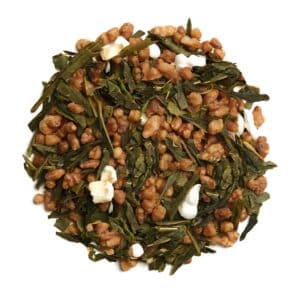Recently, I surprised myself by buying a turmeric soap bar and roasted rice tea. I never use soap bars, and rice tea sounds… weird. So how did I end up buying these products?
Easy: I was given free samples. I went into the soap store to buy a gift, and got a tiny sample of the turmeric soap. I was immediately hooked, and went back to buy a bar for myself.
I’m a regular customer at the tea store, and they give one tea bag as a sample with every purchase. Which is how I came to try — and love — roasted rice tea.

Sampling in retail and B2C businesses is nothing new. It is known to be a powerful incentive to increase order size, improve customer loyalty, and boost cross- and up-selling. (If you’re interested in reading more about retail sampling, including the psychology and science behind its effectiveness, Shopify has a great guide.) In short, reciprocity, “try before you buy,” and improving brand affinity are the main factors that make samples so effective.
So what’s the B2B equivalent? We’ve found many ways to create the Sample effect in B2B across product, marketing, sales, and customer success, and throughout the customer’s buying journey (awareness, consideration, decision, and upsell). The key is a mindset of giving and providing value, while showcasing your product and company. Here are 12 of our favorite ways to do so.
10 ways to use samples in B2B to boost sales and growth
PRODUCT
- Free trial. The “classic” B2B sample, with many advantages — and many challenges. This tactic usually isn’t available for true Enterprise B2B products, which require integration, security audits, approvals from Legal, etc. Which brings us to…
- Limited product trial. If you can’t offer a full trial version, perhaps you can carve out a component of the product into a stand-alone free trial. The key is to demonstrate value and show a “sample” that is representative enough of the full product, while also making sure prospects understand this is just a taste of the full thing.
- Demo account. When we were evaluating Marketo for the first time, a free trial wasn’t available, but we got access to a fully-functional account with dummy data. We were able to evaluate functionality and ease of use, especially when comparing to other tools that did offer free trial accounts (like Hubspot).
- Open-source tool. Many B2D startups open source a component of their product as a “free sample.” There are many considerations to offering an open source tool, but if possible, it can serve as a great “gateway drug” into your full, non-open source product offering.
- Product videos and screenshots. If you can’t implement any of the above, then demo videos and screenshots are your next bet. Not the same, but better than nothing.
MARKETING
- Any marketing material can be framed as a sample, but we recommend the ones with a strong tie-in to your product. For example, Movable Ink publishes fantastic lookbooks of email marketing campaigns — made possible through their software.

- Data journalism. Data journalism is a particularly effective way to showcase your product capabilities through content marketing. Benchmarking reports, “state of the industry” articles, and other trends gleaned from your product data are all great examples that show the type of data and insights your product includes. Here’s an example from TrueAccord, a FinTech scaleup, presenting “Buy Now Pay Later” insights based on aggregated TrueAccord data.

- Assessment / questionnaire / quiz: Use a (free) interactive questionnaire to show the type of topics and challenges your product helps with — and provide free, tailored assessment and advice for respondents. TrueAccord has a great example.

- Free analysis based on publicly available data relevant to your prospects. Run an analysis based on your prospect’s website or other publicly available info. Or maybe their competitor’s info.
SALES
- “Free strategy session” / “office hours”. This is a favorite tactic of ours. We like to offer these after webinars. The sales person provides a free consultation session, which is a combination of free advice, analyzing the prospect’s situation, and a (short!) sales pitch. In reality, this is very similar to a typical sales discovery call… but when framed as a free consultation session, the sales person is perceived as a helpful resource providing value, for free.
(Bonus – 2 samples :))
CUSTOMER SUCCESS
- Free analysis. Let’s be real: often, your product dashboards and insights are complemented by custom, manual analysis work by your CS team. If that’s the case, why not do a sample analysis during the sales process? This can be an incredibly impressive and persuasive way to keep a prospect’s attention.
- The CS team as a sample. Many startups sell a component of “professional services” or Customer Success work as part of the deal. Have the team participate in the sales process: walking through (anonymized) work with another customer, sharing best practices from their work with dozens of similar companies, and in general giving a taste of their awesomeness.
The bottom line
Giving your audience a taste of what you offer is a sure-fire way to get them to buy more. If you’re unable to provide a full-blown free product trial, try some of our other creative ideas to offer a “sample” of your product.








